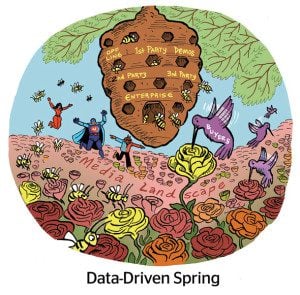The 2016 presidential election gave Americans a taste of the disinformation, misinformation and platform manipulation that’s coming for political media.
These strategies aren’t new, but tactics are more effective than ever. This year, platforms and advertisers are far more sophisticated and have greater reach, with streaming and data-driven media replacing old media that could not target communities of one.
Digital ad targeting might only reach 4% of any population in a primary. Neighbors will hear different flavors of truth. We are all bowling alone in our own filter bubbles.
Meanwhile, membership in real-world community organizing groups has thinned. Veteran political advertisers feel that “likely voters” across both parties are angrier now than in prior elections.
This is a warning.
America faces unique polarization challenges
Outside the US – in places with fewer safeguards – there will be approximately 50 national elections this year. There have already been alarming examples of disinformation being used to influence these elections. Taiwan faced an intense Chinese disinformation campaign in January. They beat it back with a “whole of society” response.
American civil society is not equipped to do the same.
Case in point: An acquaintance of mine who was a political consultant for 20 years recently decided to exit the business out of genuine belief that elections are being stolen, in line with assertions from 2020. This consultant isn’t quitting politics. He’s quitting democracy.
The biggest advertising story of our generation is the transition from broadcast to audience targeting. These days, it’s easy to push niche audiences in the direction of batshit crazy. We’ve all experienced misinformation-driven polarization take hold among peers. It is a wake-up call to acknowledge that audience targeting and online information campaigns have had some gnarly byproducts.
Political professionals should remind themselves that any sort of intense, repetitive microtargeting that plays to our reptilian brain is going to have some consequences.
Consider how political advertisers target primary voters with increasingly extreme messaging. The rest of America doesn’t hear these ads during the general election.
Or consider political fundraising. Email subject lines and text messages represent a constant state of panic. This extreme political messaging must stand out during A/B testing or else sophisticated shops wouldn’t stick with it.
Consumer businesses would never engage with customers in the same way political campaigns do. Their brands would be decimated.
The ad industry’s responsibility
Part of this polarization is on us as advertisers. The political advertising industry, from consultants and political agencies to commercial DSPs and SSPs, must take aggressive steps to self-regulate potential misuses of their technology.
This is not just a reminder to a handful of DSPs and SSPs; anyone downstream facilitating ad targeting has something to think about. If you are in the Lumascape, if you read AdExchanger, I am talking to you.
OpenAI did the right thing by banning campaigns from using ChatGPT for “generating high volumes of campaign materials.” But the product still leaks out.
The Big Tech platforms have been regulated or threatened with regulation, so they have either banned political advertising or have set up major restrictions. Political ad budgets are nothing to Meta or Google, so why bother with the controversy?
But those same budgets can woo publishers, consultants and trusting audiences.
Political campaigns can be especially dangerous at the state level because regulators are outgunned. As someone that has been in the offices of these state election regulators, I am not as confident in their abilities to protect democracy as I am in their patriotism.
And help is not coming from Washington, DC. Neither the Federal Election Commission nor Congress will pass meaningful regulations or legislation. Not this cycle. Maybe not ever.
Ad tech companies and political advertisers must self-enforce standards for audience targeting. There is immense value in learning how other verticals promote fairness and equality in digital advertising. Transparency standards akin to financial disclosures can ensure that political advertisers disclose enough without handing over their playbook.
Ad tech companies and political targeters can help elucidate how lookalike targeting can break echo chambers – and demonstrate how to draw a firm line around disinformation and deepfake creatives.
There are plenty of things we as political advertisers can do, too.
For one, buyers and ad tech can release competitive intel, even on a delay with large spend ranges. Separating the tradecraft from broad advertiser data will not hurt bottom lines.
A call to action
Several billions of dollars will be spent in political digital advertising this year. Vendors and media that win their fair share have a responsibility to repair damage to the system. Perhaps sponsor civics classes or cover the costs of summer internships on the Hill. Reinvest in democracy and you’ll continue to see rapid growth in this vertical.
The political advertising business has democracy to thank for its political and public affairs revenue. We should remember that before it’s too late.
“Data-Driven Thinking” is written by members of the media community and contains fresh ideas on the digital revolution in media.
Follow Powers Interactive and AdExchanger on LinkedIn.
For more articles featuring Jordan Lieberman, click here.


















